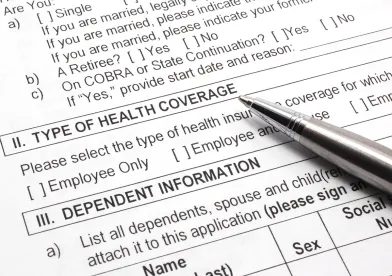On May 18, 2021, the IRS released Notice 2021-31 (the “Notice”) providing guidance on the temporary 100% COBRA premium subsidy under the American Rescue Plan Act of 2021 (“ARP”), summarized generally here. The Notice addresses how to calculate the premium subsidy and the corresponding tax credit available to premium payees, as well as the rules for claiming the tax credit.
Calculating the Tax Credit: Generally
The general COBRA rules provide that a group health plan may charge a qualified beneficiary 102% of the applicable premium for COBRA continuation coverage. According to the Notice, if the employer does not subsidize COBRA premiums for similarly situated qualified beneficiaries who are not eligible for the subsidy, then the tax credit is equal to the full premium charged to other similarly situated qualified beneficiaries for COBRA continuation coverage. Additionally, the Notice clarifies that the premium amount includes any administrative costs typically permitted to be charged with respect to COBRA continuation coverage. Thus, if an employer does not provide a subsidy for COBRA continuation coverage, the employer may claim a tax credit for the full 102% of the applicable premium.
Effect of Employer Subsidies
If the employer subsidizes all or part of the COBRA premium for similarly situated individuals who are not eligible for the subsidy, the amount of the tax credit available to the employer is the premium that would have been charged to an assistance eligible individual in the absence of the premium subsidy. The Notice clarifies that the tax credit does not include any amount that the employer would have otherwise subsidized. For example, if the full COBRA cost for continuation coverage (102% of the applicable premium) is $1,000 per month, but the employer only charges terminated employees $250 per month, the tax credit is $250.
The amount of the credit varies based on how the employer structures its severance package. As an example, assume 102% of the applicable premium is $1,000 per month, and the employer offers a 3-month period during which terminated employees may continue coverage for $200 per month, after which they must pay the full COBRA rate. Based on the Notice, the analysis is as follows:
-
If the employer considers the 3-month period part of the terminated employee’s COBRA continuation period, the available credit is $200 per month during the 3-month period, and $1,000 per month thereafter.
-
If the employer considers the loss of health coverage and the beginning of the COBRA period to occur at the end of the 3-month severance period, then the employee is not entitled to the ARP premium subsidy during that period (because the coverage is not COBRA coverage) and the employer may not claim the credit. Once the severance period ends, if the former employee (who is an assistance eligible individual) elects COBRA coverage, the credit is $1,000 per month for the remainder of the subsidy period.
The Notice contemplates that employers may change their severance programs to take advantage of the subsidy/credit. In addition, the Notice clarifies that an employer may claim the credit if it charges the full COBRA premium to all employees and qualified beneficiaries but makes a separate, taxable payment to assistance eligible individuals (i.e., pays a severance amount as taxable compensation rather than subsidizing COBRA as part of the severance packages).
How Much is the Premium Subsidy When Non-Qualified Beneficiaries are Covered?
An assistance eligible individual is any COBRA “qualified beneficiary” who loses group health coverage on account of a covered employee’s reduction in hours of employment or involuntary termination of employment. COBRA’s definition of a “qualified beneficiary” includes only a covered employee and their spouse and dependent children who were covered under the health plan on the day before the COBRA qualifying event, as well as children born to or adopted by the employee during a period of COBRA coverage. However, group health plans may extend “COBRA-like” coverage to family members who are not considered qualified beneficiaries (e.g., a domestic partner), and covered employees may add new spouses to their COBRA coverage in accordance with HIPAA’s special enrollment rules. In such instances, the employer or plan administrator will need to determine what portion of the premium is eligible for the subsidy and how much it may claim as a tax credit.
The Notice confirms that the IRS uses an incremental approach when determining the amount eligible for the premium tax credit (and subsidy) in these situations. If the cost of covering a non-qualified beneficiary does not add to the cost of covering the assistance-eligible individual(s), then the amount of the tax credit is the full COBRA premium. If covering a non-qualified beneficiary adds to the cost of coverage, then the incremental cost to cover the non-qualified beneficiary is not eligible for the COBRA premium subsidy or the corresponding tax credit.
Example: An assistance eligible individual elects COBRA coverage for himself and all of his family members who were covered under the plan on the day before the qualifying event, which includes one dependent child and his domestic partner. Under the terms of the plan, COBRA coverage for an employee plus-two-or-more-dependents costs $800 per month, and the COBRA premium is $600 per month for self-plus-one-dependent. Accordingly, the incremental cost of covering the domestic partner is $200 per month. As a result, the individual will pay $200 per month for COBRA coverage for his domestic partner, and the premium payee may claim the $600 per month as a payroll tax credit for the subsidy.
Takeaway
The Notice provides useful guidance on the calculation of the premium subsidy and the corresponding tax credits in various circumstances. However, the calculations may be less than straightforward depending on the facts and circumstances, particularly where post-termination coverage is subsidized, or if the plan voluntarily provides continued coverage to individuals who are not otherwise qualified beneficiaries. When in doubt, reach out to legal counsel for advice.





 />i
/>i

